This article outlines the quantification of surface energy and how plasma treatment can ultimately be employed to modify surface energy to enhance bonding and adhesion.
What is ‘Surface Energy’?
Molecules inside the bulk of a material are bordered in all directions by additional molecules. Some of these bonds must be broken to produce a surface.
Energy is required for this process. An amount of this additional energy is ‘stored’ in the surface as the molecules are no longer bordered on all sides by the same molecules as in the bulk, meaning that some bonds are unsatisfied.
Surface energy is determined by the excess energy at the material’s surface contrasted to the bulk material alone.
The process that occurs when a liquid is in contact with a surface will now be considered. Liquids contain the well-established characteristic of surface tension.
If the liquid’s molecules have a weaker attraction to the surface than to each other (namely, they have a higher surface tension), then beads will be produced because the liquid will not penetrate the surface effectively.

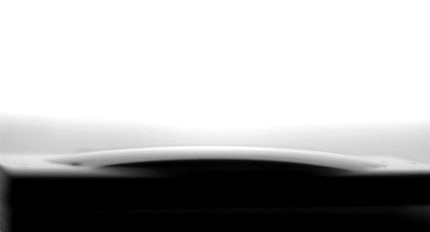
Figure 1. Water beading on a low surface energy material (left) and water spreading on a high surface energy material (right).
In contrast, if the molecules are more strongly attracted to the surface, then the liquid will be more dispersed.
It can then be deduced that if a specific surface has a higher surface energy it will wet more effectively. It will be simpler to bond, paint, print or glue to that surface because the ability to wet a surface is a basic definition of the surface’s adhesion features.
Surfaces that contain mainly carbon-hydrogen (C-H) bonds are prone to lower surface energy which means they do not easily wet.
Surfaces containing many oxygen-hydrogen bonds (O-H) have a higher surface energy which gives them superior adhesion features. Polypropylene and polyethylene are examples of surfaces with low energy and the majority of metals have a surface energy that is inherently higher.
Why is Surface Energy Important?
The data presented below provides examples of the surface tension of common liquids and the surface energy of a few popular polymers. In each example, the liquid’s surface tension is higher than the polymer’s surface energy. This would produce ineffective adhesion due to insufficient surface wetting.
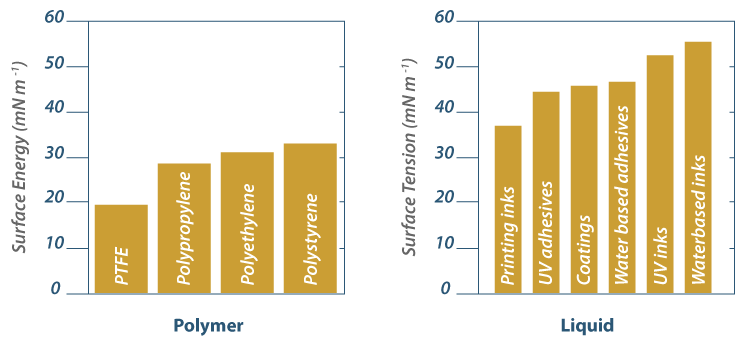
Image Credit: Henniker Plasma
How Can Plasma Treatment Help?
The goal of plasma treatment is to convert low energy surfaces to higher energy surfaces through surface activation. Activation is the mechanism by which polar molecules (molecules including oxygen) are bonded to the surface from the plasma.
For the examples above, the consequent increase in surface energy is demonstrated below. This increase means that popular adhesives and inks can now produce very strong bonds to the materials that have been plasma treated.
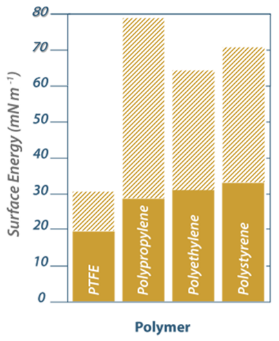
Image Credit: Henniker Plasma
How is Surface Energy Calculated?
There are multiple techniques to determine the surface energy of a solid, and they all depend on the quantification of the angle that is produced at the solid/liquid interface.
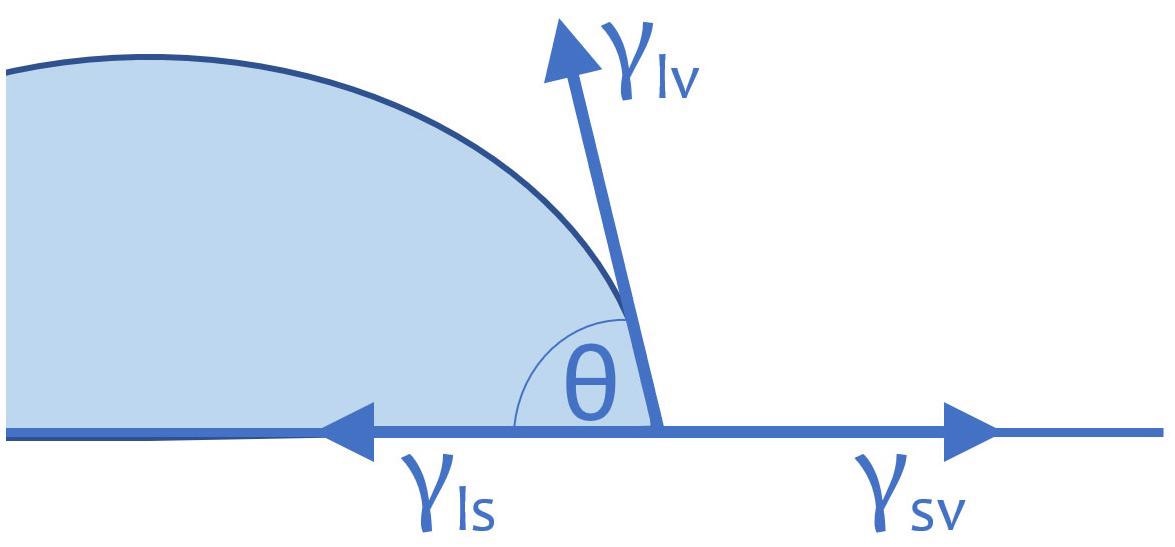
Image Credit: Henniker Plasma
The simplest expression to outline the process above is Young’s equation, which represents the balance of forces detailed above and provides a technique for the calculation of surface energy:

Where γs is the solid’s surface energy, γsl is the interfacial tension between solid and liquid, γl is the liquid’s surface tension, and θ is the liquid’s contact angle on the solid.
Commercial devices for contact angle measurement utilize a range of extra assumptions and measurements to establish the surface energy value from the equation above, along with the determination of the contact angle.
Which Other Tests can be Used to Measure Surface Energy?
Water Break Test
A water break test is a highly efficient and simple qualitative test utilized to determine if a treated material’s surface energy is more than 72 mN/m which is the surface tension of de-ionized water.
The treated material is brushed with water (where possible, the object can also be submerged in water), and if beads are created on the surface, then the surface energy will be less than 72 mN/m. The surface energy is more than 72 mN/m if the water diffuses and wets the surface.
Dyne Test Fluids

Image Credit: Henniker Plasma
Dyne test fluids are a semi-quantitative, cost-effective measurement of surface energy that needs no special training. Fluids can be purchased in graduated energy level sets in the form of marker pens or as a bottled ink with a brush applicator.
In both techniques, the test fluid’s increasing graduations (energy level) are simply drawn over the surface in sequence. Fluids with a lower energy level will form beads on the surface which suggests that the surface energy is less than that of the fluid employed.
The surface energy is almost equal to that of the fluid if a specific fluid does not form beads but diffuses evenly on the surface instead. The test fluids are available in a red, green or blue color, and the surface energy is usually expressed in units of dynes/cm or mN/m.
Blue fluids are formulated to DIN ISO8296 and are formamide-based (toxic), meaning that the results are similar between various laboratories or manufacturing locations.
Green and red fluids are based on alcohol (non-toxic) and, so strictly speaking, are not proportionate between sites, although they are normally viable for the majority of cases.
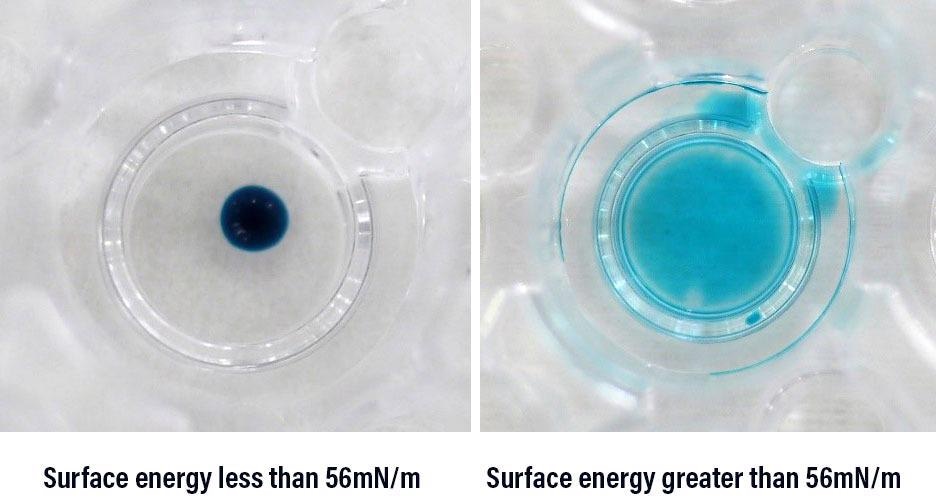
Image Credit: Henniker Plasma
Contact Angle Measurement
Contact angle instruments, as outlined before, can optically analyze a drop of liquid’s shape when in contact with a surface. An efficient analysis software and image capturing camera can be used to achieve this.
The contact angle and drop shape are dependent on both the surface energy and topography of the surface of the solid.
The liquid creates a drop with a low contact angle (θ < 90o) when attracted to the solid (material with the greater surface energy).
The contact angle is high (θ > 90o) if repelled, showing it is a material with a low surface energy. The contact demonstrates a quantitative measure of surface energy.
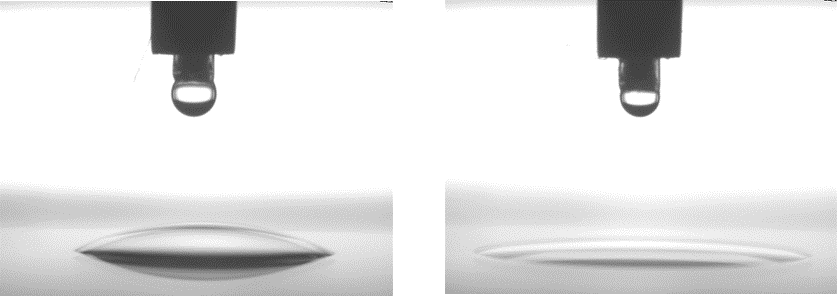
Image Credit: Henniker Plasma
The image above presents a standard contact angle image captured prior to and after plasma treatment. The quantified surface energies are 83.3 mN/m and 56.8 mN/m.
Adhesion Grid Cut Test
The grid cut test is a direct visual quantification of thin film adhesion, for example, paint. A crosshatch pattern is utilized to score the paint film before an adhesive tape is added and then removed.
Permanently bonded material will stay on the surface, whereas material that is poorly bonded will be removed from the surface. The technique is covered under ISO 2409:2020.
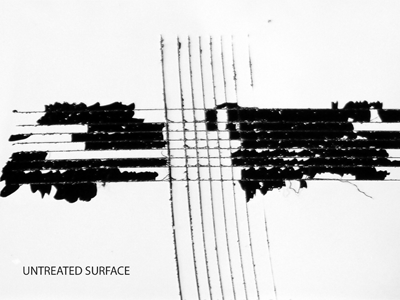
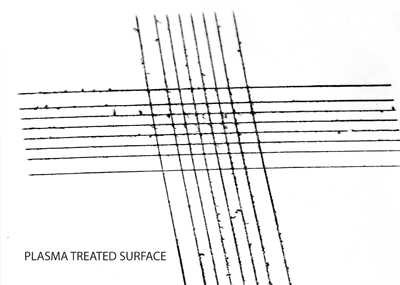
Image Credit: Henniker Plasma
Henniker has advanced surface testing and plasma processing facilities to perform plasma process trials and surface energy testing to establish the efficacy of plasma treatment for a broad range of samples.
To learn more, contact Henniker today.
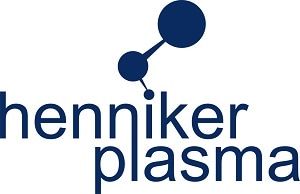
This information has been sourced, reviewed and adapted from materials provided by Henniker Plasma.
For more information on this source, please visit Henniker Plasma.